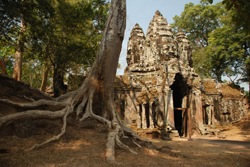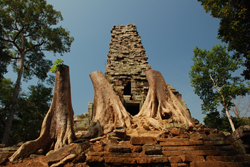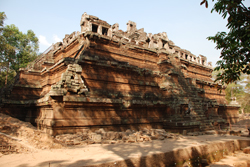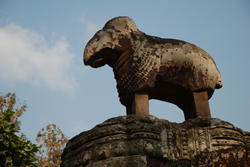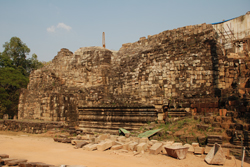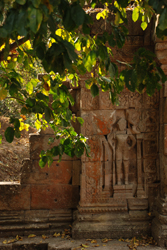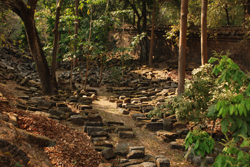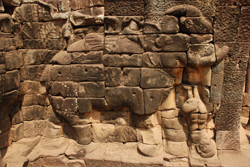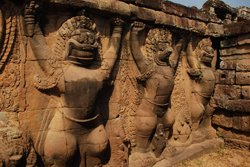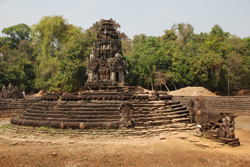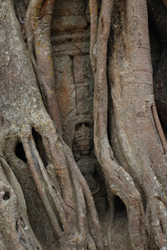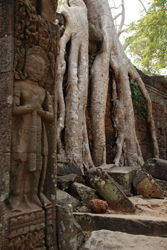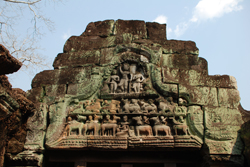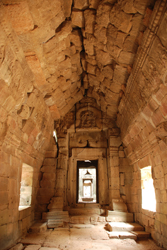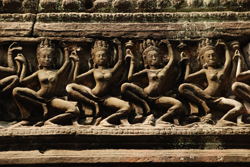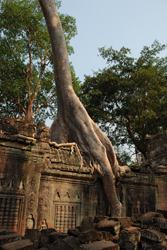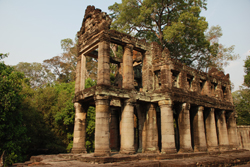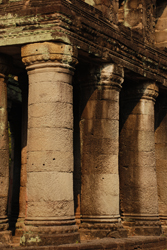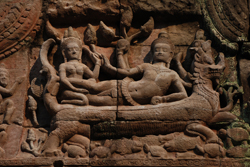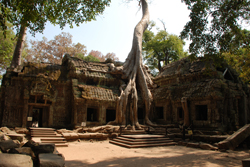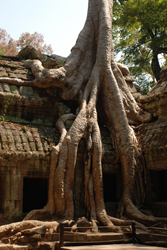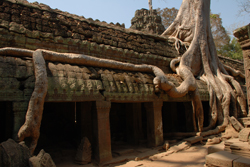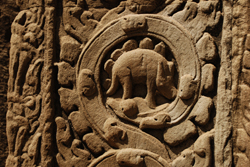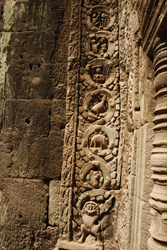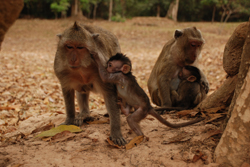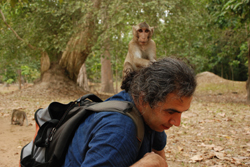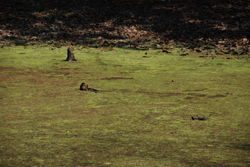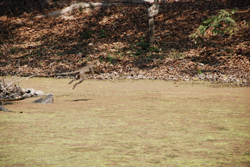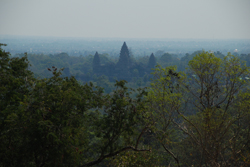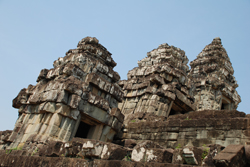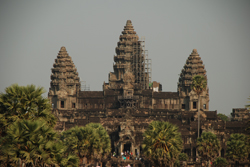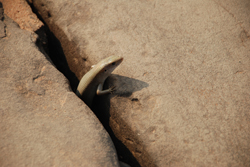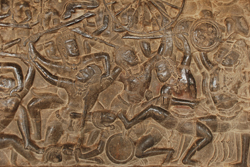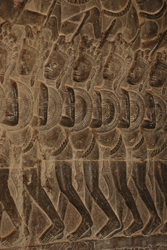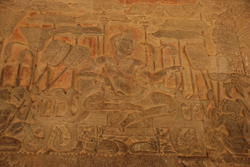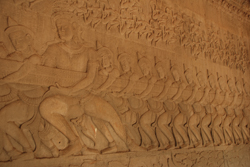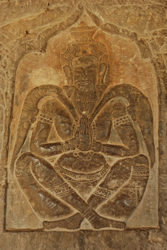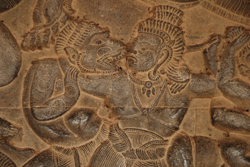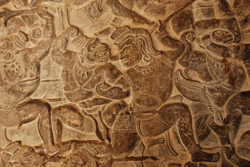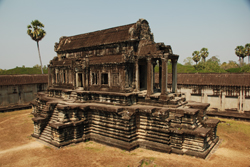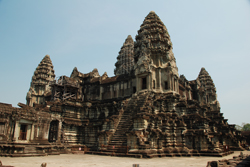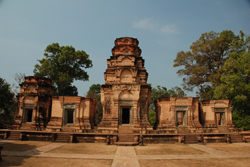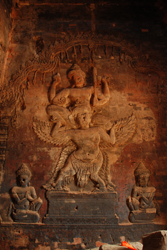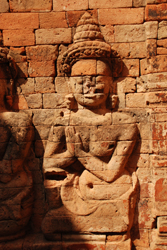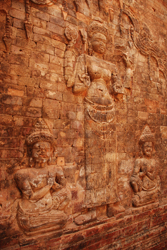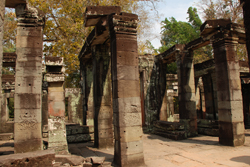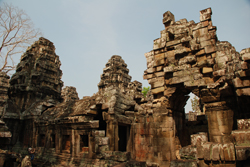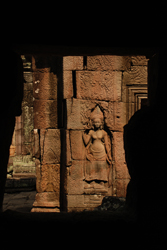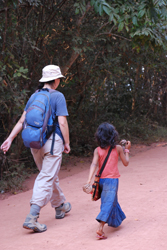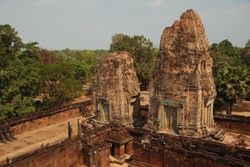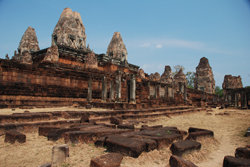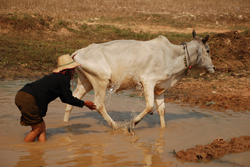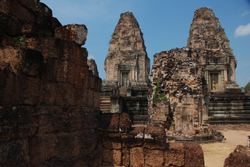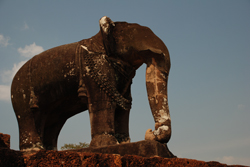Angkor: Elephants, Monkeys, A Stegosaurus, and A Giant Chicken
5 February, 2009, 02:39 am in "Cambodia"
Starting at the North Gate, we visited several different sites in Angkor Thom. The following are short descriptions of some more of the sites around Angkor.
Preah Palilay: is a very rickety looking vertical tower with several stumps of fig trees which had once been growing from it. Their roots seemed to crawl between the stones like lizards.
Preah Palilay: is a very rickety looking vertical tower with several stumps of fig trees which had once been growing from it. Their roots seemed to crawl between the stones like lizards.
Phimeanakas: is a climbable though a bit rickety looking stone structure (a wood stairway ad been added on one side). There were several statues on the corners. One looked strangely like a sheep but had in truth been an elephant whose trunk and ears had broken off. The other 3 sides of the tower were off limits.
The Baphuon is also undergoing extensive reconstruction. However, a sign with an arrow said, “Access to the Buddha”. A wooden staircase led to a higher level with a view of reconstruction work and a bizarre, almost wavy looking stone wall. There were posters about the issues of restoration/reconstruction (big one being it was built structurally flawed to begin with). I didn't see any Buddha, though. Then Rowshan pointed out a huge face at one end of the wavy rock wall which was actually the body of a huge reclining Buddha.
Elephant Terrace: Lots of elephants and riders. Elephants fighting wild animals, elephants with kids swinging from their trunks, elephants marching through the jungle, elephants battling a Wild Thing, elephants... elephants everywhere... After the elephants was a whole wall of disco sumo birds. Next to the Terrace of the Elephants was the Terrace of the Leper King.
Neak Pean: a nice little tower in a pool surrounded by 4 pools, each with a different water spout-- only no water.
Ta Som: is famous for a tree in the process of crushing one of its gates. As we parked our bikes, a girl came up selling drinks. Rowshan said, “No, No, No...” making it into a song. (the vendors are really getting on our nerves) After he did this for about a minute, he stopped and she continued, “If you buy one drink...” “NONONONONONONONONONO!!!” Rowshan continued until someone called her away.
Preah Khan: had been a monastery and was very large. There was an interesting 2 story building with round columns on the first story. The monastery/school was built like an X with 4 gates and 4 main passageways to the center. However the 4 entrances weren't symmetrical. The ruins were busy but there were some quiet spots. There were also some pretty trees crushing sections of the walls and towers.
Ta Prohm: is a monastery/ temple but had a lot of work going on around it. The jungle has been doing its best to reclaim it. Huge fig trees grow from the walls with roots spread over the stone chambers and crushing them as if they were hands of a giant. The jungle seemed very audible this morning with strange croaks whistles and chirps. Huge piles of collapsed stones stood between the remaining chambers. One tree was reminiscent of a giant squid consuming a ship.
We had to go back to Ta Prohm the next day in order to look for the stegosaurus. I learned about it last night from a newspaper article. On one of Ta Prohm's towers is a little carving in a circle of a stegosaurus in a row of carvings of more mundane things. It isn't known if it is genuine or a restoration worker's joke-- but it is there. The newspaper columnist who mentioned it said it could be a Sumatran rhino or pangolin (an anteater that looks like an armadillo). It could also be just a whimsical creation. I find a lot of the creatures carved have interesting unrecognizable appearances-- the disco sumo birds, for example.
On our way back towards Angkor Wat, Rowshan asked, “Where are all the monkeys?” The monkeys who frequent the forest near the road just inside Angkor Thom, were strangely absent. “Maybe they take a siesta,” I suggested. A few minutes later Rowshan called out, “STOP! Look!”
In a water weed filled point, the little monkeys were all taking a swim, just as kids would on a hot day. They paddled and splashed each other. Then they took turns jumping from a partially submerged tree into the water. I almost expected them to start diving... but they stuck to flailing leaps.
Phnom Bakheng: is a temple on a hill with a view of Angkor Wat, the lake, and lots of jungle. There is a forested path up the hill... actually there are 3 paths as described on a sign: the “elephant path” which switchblades up the hill (for elephant rides), the “safe path” which slowly circles the hill and the “dangerous path” which goes straight up and was blocked off. The temple was empty-- apparently it is only crowded sunrise and sunset.
Angkor: Visiting Angkor Wat
4 February, 2009, 02:39 am in "Cambodia"
Angkor Wat did not look crowded, unlike the other times we biked by. So we went in. The reason it wasn't crowded was we were there at 10 and the tours go either in the morning for sunrise or afternoon because the light is better. The view was a little hazy since the sun was behind it-- but Rowshan had taken view photos yesterday evening. The important thing was no crowds.
Angkor Wat was designed to take you from the world of men to the realm of the gods. The design is based on Hindu mythology and represents Mt. Meru, the home of the gods. Mt. Meru is a 5 peaked mountain (represented by the towers) which is the center of the universe. It is surrounded by 6 mountain chains and oceans. Although Angkor Wat's mountain doesn't have 6 mountain chains it does have several walled galleries surrounding it and a large moat.
Angkor Wat was designed to take you from the world of men to the realm of the gods. The design is based on Hindu mythology and represents Mt. Meru, the home of the gods. Mt. Meru is a 5 peaked mountain (represented by the towers) which is the center of the universe. It is surrounded by 6 mountain chains and oceans. Although Angkor Wat's mountain doesn't have 6 mountain chains it does have several walled galleries surrounding it and a large moat.
Walking down the long wide bridge of huge flag stones to the gate and then another long path lined with naga balustrades to the wat gives one the feeling of journeying to another realm. In the morning, fuchsia lotuses bloom in the reflecting pools in front of the wat though they disappear as the sun gets hotter.
The first gallery layer which makes up the outer walls of the wat takes the visitor on another journey through history and legend, guided by bas relief murals carved into blocks of sandstone.
The South-Western wall, the first we walked along, was the overwhelming chaos of the battle of Kurukshetra-- a very large part of the Mahabarata, an Indian (Hindu) epic popular in Cambodia until it faded with the decline of Angkor. The wall was covered with layers of people on foot, and in chariots fighting. All seemed to have slightly different positions even when they were in lines.
The South-Western wall, the first we walked along, was the overwhelming chaos of the battle of Kurukshetra-- a very large part of the Mahabarata, an Indian (Hindu) epic popular in Cambodia until it faded with the decline of Angkor. The wall was covered with layers of people on foot, and in chariots fighting. All seemed to have slightly different positions even when they were in lines.
After the chaos and motion of the figures on the battle wall, we entered a corner chamber which was suddenly calm. The walls had all these figures calmly sitting-- even cows and horses. The ceilings of this corner were corbeled vaults about 30 feet high. Angkor Wat is massive. Just th outer gallery is this tall (and set about 20 feet above the ground) The progressive layers are higher.
The West portion of the Southern wall depicted historical events related to the reign of King Suryavarman II, the founder of Angkor. We found ourselves walking with an orderly procession of carved people on the lower section of the mural bringing tribute. The 2nd level of the mural had seated soldiers. Behind the procession were forests of trees, with each leaf depicted, animals and birds. The mural depicted patterns in clothing, different head dresses, and jewelry. Towards the center was the king surrounded by courtiers and servants. Then the scene went through a transition and became a battle scene with soldiers and elephants. The transition also was one where 2 levels (upper and lower) became just one scene. This was done by having the soldiers on the top level march down a “hill” from top to lower level making the scene into just one level.
The West portion of the Southern wall depicted historical events related to the reign of King Suryavarman II, the founder of Angkor. We found ourselves walking with an orderly procession of carved people on the lower section of the mural bringing tribute. The 2nd level of the mural had seated soldiers. Behind the procession were forests of trees, with each leaf depicted, animals and birds. The mural depicted patterns in clothing, different head dresses, and jewelry. Towards the center was the king surrounded by courtiers and servants. Then the scene went through a transition and became a battle scene with soldiers and elephants. The transition also was one where 2 levels (upper and lower) became just one scene. This was done by having the soldiers on the top level march down a “hill” from top to lower level making the scene into just one level.
The Eastern section of the South wall was a journey through 37 heavens and 32 hells from the Indian tradition. On another wall, a portion of the “Churning of the Sea of Milk” mural was being restored. Lots of the main temples of Angkor are in the process of restoration or reconstruction by international organizations from Japan, German, France and others.
The North section of the East wall was carved in the 16th century and represented scenes from the Indian epic Harivamsha in which Vishnu fights and defeats all the demons. Vishnu was surrounded by the chaos of demons he defeats. The next wall showed more battles of the the gods, ending with a series of caves with meditating figures inside.
The last wall we looked at depicted a battle from the Ramayana in which Rama, an avatar of Vishnu, battled King Ravana's army. Rama was aided by Hanuman and his army of monkeys. The monkeys often were attacking by biting peoples' faces.
From there we progressed to the inner levels which were another 20 feet higher than the outer gallery-- raised on a base of rock and earth. Angkor Wat was surprisingly quiet. Everyone comes for dawn or dusk but most of what you look at is sheltered inside so it really doesn't matter what time you visit. We were grateful we visited when we did. The mid day heat was broken by breezes whispering along the cool stone corridors and the shady vaults.
The inner sanctuary, up another 2 levels was closed for restoration. The towers have carvings on the exterior and lotus petals on top. The eroded sandstone they are made of gives them a slightly melted appearance. A myna bird called, seemingly mimicking a monkey, from one of the towers. The inner sanctuary reminded me of a giant sand castle.
In the level below was a standing Buddha. A group of orange-clad monks walked in and soon everyone was photographing them. The monks seemed to be very patient.
Angkor: Another Day at Angkor
3 February, 2009, 02:39 am in "Cambodia"
We had to bike about 9 km to get to our first stop, Prasat Kravan, a series of 3 brick towers from the 10th century (though reconstructed in the early 20th century). The central tower had 5 levels getting gradually smaller. The bricks had been arranged to create step arches and levels. Inside the central and right towers were beautiful bas reliefs of Vishnu (center tower) and Lakshmi (right tower).
Banteay Kdei was built in the late 12th to early 13th century. We entered through a gate with the characteristic large faces. The first building had lots of faint Buddhist carvings of someone in a lotus position though many were scratched out. Though the monastery complex was a popular stop for tour groups, it was large enough to escape and sit quietly in the ruins surrounded by large stone blocks and tilted columns and towers. The other main buildings had apsara column carvings. Piles of stones-- some with traces of carved decorations-- littered the ground. Huge spiderwebs adorned the corners of lintels and arches.
One thing that is hard to deal with at Angkor are the touts at the entrance of many of the sites selling books, souvenirs and drinks. At Bantae Kdei, they were inside as well. Children try to sell things then beg for candy. Sometimes you say no and they still try to persuade. It makes me hate people but then I feel like a jerk because they are just trying to make a living.
Pre Rup rises unexpectedly from the flat landscape as if the Khmers wished to make up for the lack of hills in the area. Its base and the towers are built of red sedimentary stone which is now pockmarked since the sediments have weathered out making it look like lava. The red stone contrasts nicely with the green jungle.
Though most of the street we'd been biking on were surrounded by jungle, the stretch after Pre Rup opened up and we were among rice paddies where water buffalo walked. On our way back Rowshan saw a woman giving a bull a bath.
Our last stop was East Mebon, another temple mountain. This one used to be on an island surrounded by water of a reservoir (Baray) but now it is dry. There were some nice elephant statues and carved doorways of the towers. It was afternoon and kind of hot so we headed back stopping to get a quick look at the crowded Angkor Wat.
Powered by My Blog 1.69. Copyright 2003-2006 FuzzyMonkey.net.
Created by the scripting wizards at FuzzyMonkey.net..
(Code modified by Rowshan Dowlatabadi)
Created by the scripting wizards at FuzzyMonkey.net..
(Code modified by Rowshan Dowlatabadi)



